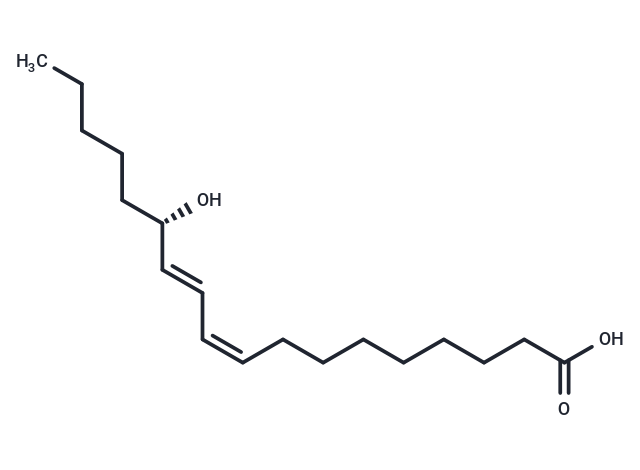 Your shopping cart is currently empty
Your shopping cart is currently empty

(S)-Coriolic acid (13(S)-HODE) is an important intracellular signaling agent generated by the reaction of linoleic acid with plant and mammalian lipoxygenases. It is involved in cell proliferation and differentiation in various biological systems and inhibits the adhesion of tumor cells to the vascular endothelium, while down-regulating IRGpIIb/IIIa receptor expression at around 1 μM. Additionally, (S)-Coriolic acid is a metabolite of 15-lipoxygenase (15-LOX) and often acts as an endogenous ligand to activate PPARγ. It induces mitochondrial dysfunction and airway epithelial damage.

| Pack Size | Price | USA Warehouse | Global Warehouse | Quantity |
|---|---|---|---|---|
| 100 ug (337.33 μM* 1 mL in Ethanol) | $389 | - | In Stock | |
| 250 ug (337.33 μM * 2.5 mL in Ethanol) | $780 | - | In Stock | |
| 500 ug (337.33 μM * 5 mL in Ethanol) | $1,450 | - | In Stock |
| Description | (S)-Coriolic acid (13(S)-HODE) is an important intracellular signaling agent generated by the reaction of linoleic acid with plant and mammalian lipoxygenases. It is involved in cell proliferation and differentiation in various biological systems and inhibits the adhesion of tumor cells to the vascular endothelium, while down-regulating IRGpIIb/IIIa receptor expression at around 1 μM. Additionally, (S)-Coriolic acid is a metabolite of 15-lipoxygenase (15-LOX) and often acts as an endogenous ligand to activate PPARγ. It induces mitochondrial dysfunction and airway epithelial damage. |
| In vitro | (S)-Coriolic acid (30 nM; 6 h; E-FABP-/- keratinocytes) induces K1 expression through NF-κB activation. (S)-Coriolic acid also increases the phosphorylation of Ikkinase-bat tyrosine 199, which promotes IκBα phosphorylation and subsequent NF-kB activation. (S)-Coriolic acid increases the phosphorylation of IκBαat serine 32, which induces IκB degradation and thereby activates NF-κB.[3] |
| In vivo | (S)-Coriolic acid (0-0.6 mg; intranasal; once daily for 3 consecutive days; mouse) induces significant airway dysfunction, neutrophilia, mitochondrial dysfunction, and epithelial injury.[2] |
| Synonyms | 13(S)-HODE |
| Molecular Weight | 296.44 |
| Formula | C18H32O3 |
| Cas No. | 29623-28-7 |
| Smiles | C(=C/C=C\CCCCCCCC(O)=O)\[C@H](CCCCC)O |
| Relative Density. | 0.970 g/cm3 (Predicted) |
| Storage | Pure form: -20°C for 3 years | In solvent: -80°C for 1 year | Shipping with blue ice/Shipping at ambient temperature. | ||||||||||||||||||||||||||||||||||||||||
| Solubility Information | Ethanol: >50 mg/mL (per Rao Maddipati), Sonication is recommended. DMSO: 55 mg/mL (185.54 mM), Sonication is recommended. PBS (pH 7.2): 1 mg/mL (3.37 mM), Sonication is recommended. DMF: >50 mg/mL (per Rao Maddipati), Sonication is recommended. | ||||||||||||||||||||||||||||||||||||||||
Solution Preparation Table | |||||||||||||||||||||||||||||||||||||||||
PBS (pH 7.2)/DMSO
DMSO
| |||||||||||||||||||||||||||||||||||||||||
| Size | Quantity | Unit Price | Amount | Operation |
|---|

Copyright © 2015-2025 TargetMol Chemicals Inc. All Rights Reserved.